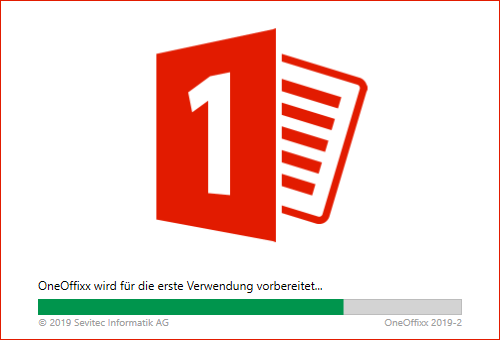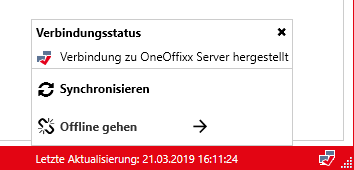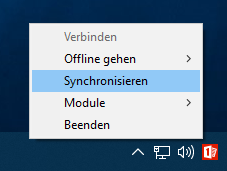Synchronization
The OneOffixx Client is connected to the OneOffixx service via the Service-URL. The service URL can be specified during installation or configured in the installation directory in the file "OneOffixx.exe.config" in the value attribute as follows:
<configuration>
[...]
<appSettings>
[...]
<add key="ServiceAddress" value="https://your-url.local/Service/OneOffixxService.svc" />
[...]
</appSettings>
[...]
</configuration>
Initialization
When OneOffixx is started for the first time, the data is synchronized first. Once this synchronization is complete, OneOffixx can be used. For all following synchronizations only the changes will be retrieved.

Sync interval
Concept
The OneOffixx Client automatically retrieves the latest changes from the service on a cyclical basis. Here it is important that not all OneOffixx clients of a company contact the service for a synchronization at the same time, in order to prevent large server loads and thus downtime risks.
A small synchronization interval can cause (especially if there are changes to "pick up") a high server load. A high server load could also occur if many devices try to synchronize at the same time, e.g. if all clients start up at about the same time on Monday morning.
To avoid the problem of high server load, two values are configurable:
Configuration
The client synchronization can be configured in the dashboard in "Settings":

The values of ClientSyncInterval and ClientSyncMaxDelayAfterStart are transferred during each synchronization and stored locally by the client.
ClientSyncInterval: time interval between synchronizations
The ClientSyncInterval specifies the maximum time that elapses before the client synchronizes again. The value is specified in milliseconds. The default value is 900'000 milliseconds (15 minutes).
The actual time that elapses between synchronizations is calculated as follows: Up to 10% of the waiting time is randomly subtracted from the time configured in ClientSyncInterval.
Example: With a ClientSyncInterval of 15 minutes, the actual waiting time until the next synchronization is randomly between 13.5 and 15 minutes.
When the program is started, it is evaluated whether the interval time has already passed since the last successful synchronization. If this is not the case, the remaining time is calculated. From this again randomly up to 10% of the waiting time is subtracted.
So, if at the start of the program the last successful synchronization was 42 hours ago and the ClientSyncInterval is 48 hours, then the time left until the next synchronization is a maximum of six hours. After counting off a maximum of 10%, the result is a value between 5.4 and 6 hours.
If the interval time has already passed since the last successful synchronization, the next item "ClientSyncMaxDelayAfterStart" applies.
ClientSyncMaxDelayAfterStart: Maximum delay after program start
If a client starts and the last successful synchronization was longer ago than the configured interval time, then the ClientSyncMaxDelayAfterStart comes into play.
The synchronization happens in this case not immediately, but delayed. The reason is that if we assumed a ClientSyncInterval of two hours and in the morning at 8.00 a.m. many employees started OneOffixx at the same time, all these clients would synchronize in the same minute, which would lead to an excessively high server load.
The ClientSyncMaxDelayAfterStart specifies the maximum amount of time that passes before the client synchronizes when it should have already synchronized at program startup due to the elapsed interval. The value is specified in milliseconds. The default value is 3'600'000 milliseconds (1 hour). If ClientSyncMaxDelayAfterStart (e.g. 1 hour) is higher than ClientSyncInterval (e.g. 15 minutes), then the value of ClientSyncInterval (thus 15 minutes in the example) also applies to ClientSyncMaxDelayAfterStart.
The actual delay is determined randomly. It is between 0 and the number of milliseconds specified in ClientSyncMaxDelayAfterStart. Thus, the server load can be distributed if, for example, with a ClientSyncInterval of 1 day, all clients have to synchronize on Monday morning.
Manual synchronization
Additionally, there is the possibility to trigger a synchronization manually. On the one hand, this can be triggered by clicking on "Last update" in the status bar in the client at the bottom right and then on "Synchronize".

On the other hand, you can right-click on the OneOffixx icon in the notification area and then select "Synchronize".

Cache version
The client checks at startup if the cache is still valid.
When the "Service URL" is changed, the cache is always reset.
If you now update the Windows client, it checks whether the structure of the cache still matches the new version.
If the cache is valid, no new cache is built.
Caution
During uninstallation the cache is cleared. I.e., OneOffixx.exe /clean will still be called. If the update is executed as uninstallation and installation, a backup of the cache must be created beforehand in another way and restored before the first OneOffixx start. This can be a simple renaming of the cache folder, for example, – OneOffixx does not need an available cache during the /clean command.